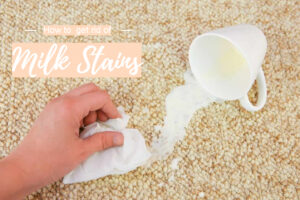
Milk is widely used for tea, coffee, meals, and baking. While you should not cry over spilled milk, the stains it can leave behind can make you tear up. Milk is made of liquid protein and along with the fats in it, it can not only leave very noticeable stains but also cause a bad smell.
The good news we have is that removing milk stains from upholstery and carpets is absolutely possible – even if you have a velvet, microfiber, or suede furniture piece. The best part is that you only need to use common household items to get rid of milk stains.
Cleaning milk stains from couches and carpets
- Scoop, then blot – If there is a large amount of milk (or even yoghurt) scoop as much of it as possible using a spoon. Start at the outside of the spill and scoop towards the centre to prevent spreading. Grab a clean dry cloth or a paper towel and start blotting to absorb as much liquid as possible. Avoid rubbing since that may push the milk further into the fibres and make it harder to remove.
- Blot with a damp cloth – Dip a cloth in plain cool water and damp at the stain, again starting at the outer edge and working your way towards the centre. Make sure you are not oversaturating the area, especially if you are cleaning an upholstery piece since any trapped moisture can cause mould and mildew growth.
- Mix a cleaning solution – Mix 2 cups of warm water and 1 tablespoon of dishwashing liquid.
- Clean the stain – Dip a clean cloth or a sponge and start gently working the stain out of the fabric. Start at the outer edge and work your way towards the centre. Move to a clean area of the cloth as the stain transfers and keep doing this until the stain is completely gone. Rinse the area with a clean cloth dipped in plain water at the end. Make sure you remove any soapy residue because it may attract dirt and soil in the future.
Extra tip: If you are having a hard time removing the stain, mix a solution of oxygen bleach and water (follow the instructions on the packaging). Use a cloth to blot it onto the area. Test in an inconspicuous area to avoid damage. Let the oxy-bleach solution sit on the stain for 30 minutes at least. Grab a cloth dipped in plain water and ‘’rinse’’ the area.
Cleaning milk stains from washable clothing
For fresh milk stains, hold the cloth under a running faucet with cold water with the wrong side facing up. The power of the water will flush the milk out of the fibres. When done with this step, throw your garment into the washing machine and use a heavy-duty laundry detergent. Check if the stain remains and if that is the case, repeat the steps. Do not throw the garment into the dryer if the stain is not completely gone. The heat from the dryer will cook the protein in the milk and make the stain harder or even impossible to remove.
For old stains on washable clothing brush off the dried matter first. Use a plastic scraper or a spoon to remove as many of the solid particles as possible. For more fragile fabrics, use a soft-bristled brush to complete this step. Then soak the garment in cold water mixed with some heavy-duty laundry detergent for at least 30 minutes, then gently scrub at the stained area with a soft-bristled brush. Toss the fabric in the washing machine and wash as usual. Make sure the stain is completely gone before putting it in the dryer.
For tougher stains, mix a solution of oxygen bleach and cold water and let the piece of clothing soak in it for a few hours or overnight. If the stain remains, mix a fresh solution and repeat the process.
Additional tips
Furniture: If you did not manage to clean the milk stain immediately, it may have set and developed a sour smell. Remove the couch cover if possible and wash it separately. Clean the milk stain using the steps above, then sprinkle the area with baking soda and let it sit overnight, then vacuum or brush the powder away at the end.
Clothing: The steps we mentioned above for washable clothing are also suitable for removing chocolate or other cream stains. If treated properly, the stains, along with the bad smell will be removed completely.
Make sure you do not leave milk stains sitting in. Once they dry, it will be much harder to get rid of them, as well as completely remove the smell. The milk will penetrate into the fabric fibres and you will have a hard time trying to get rid of it.
